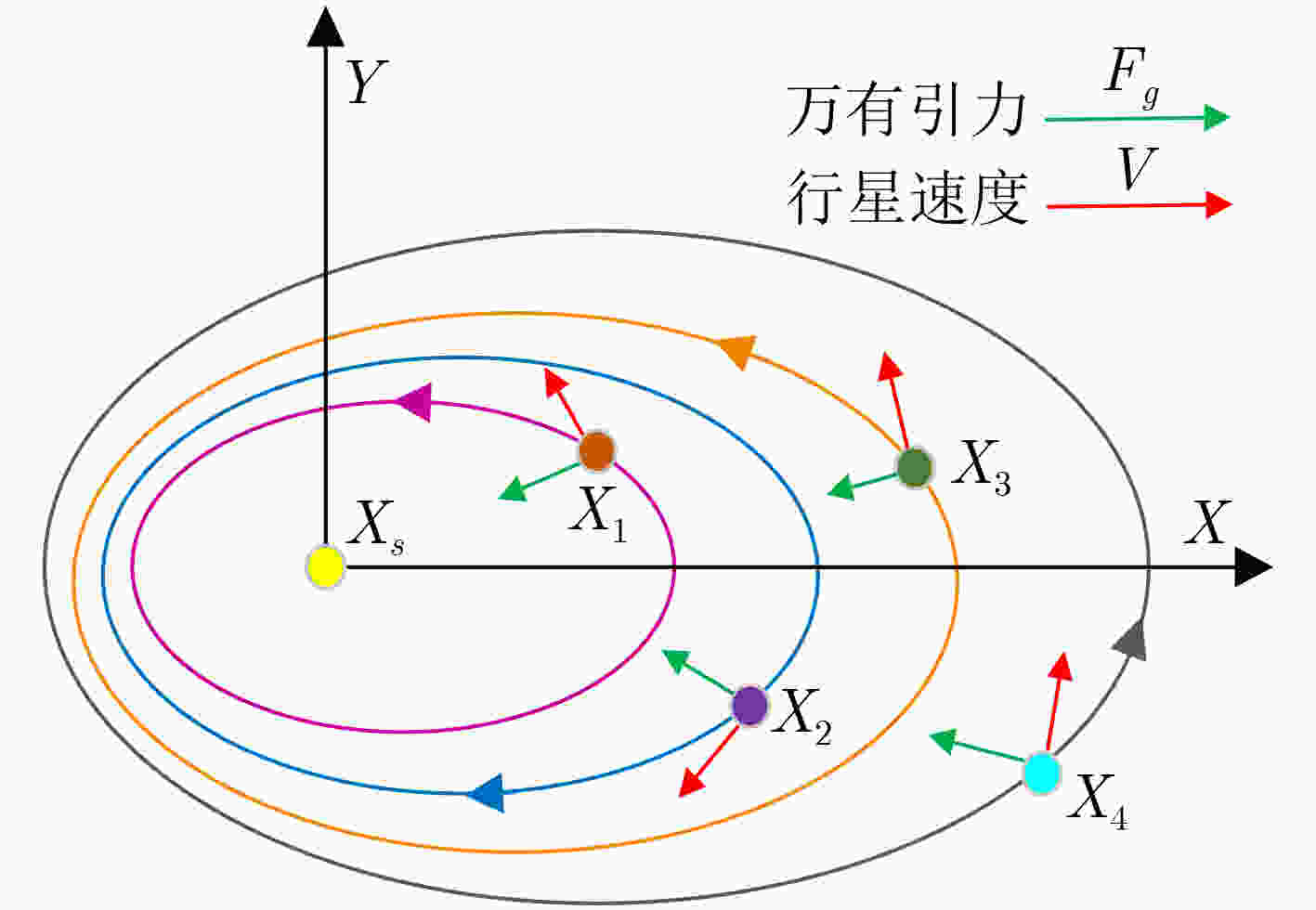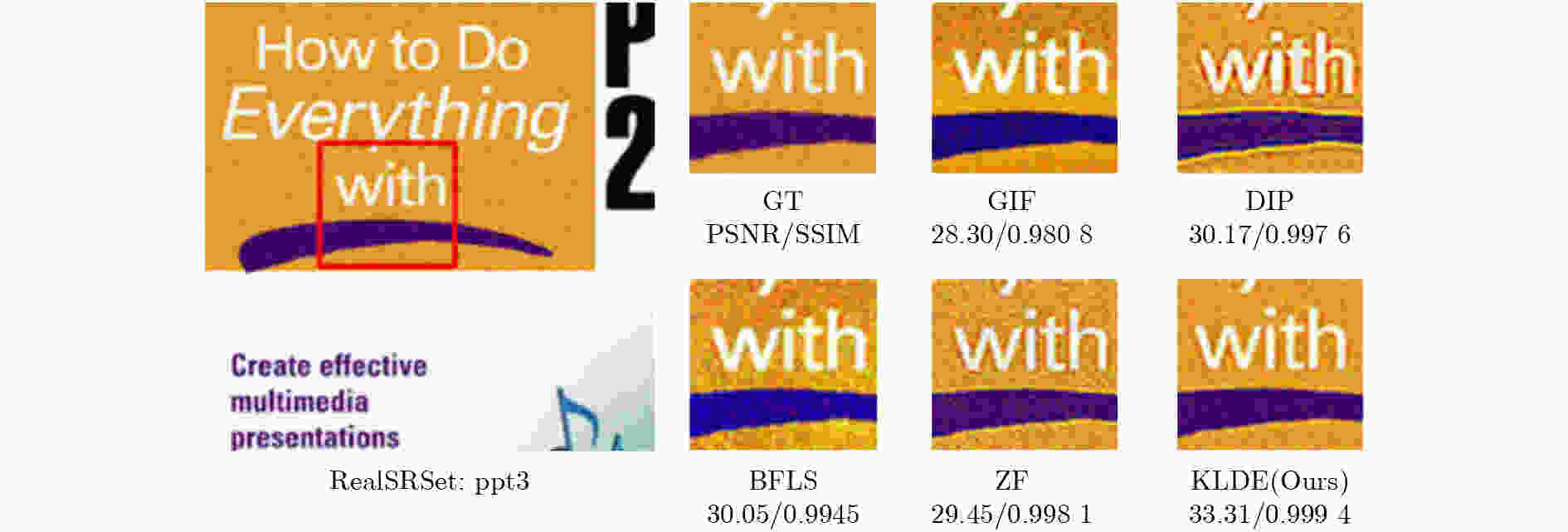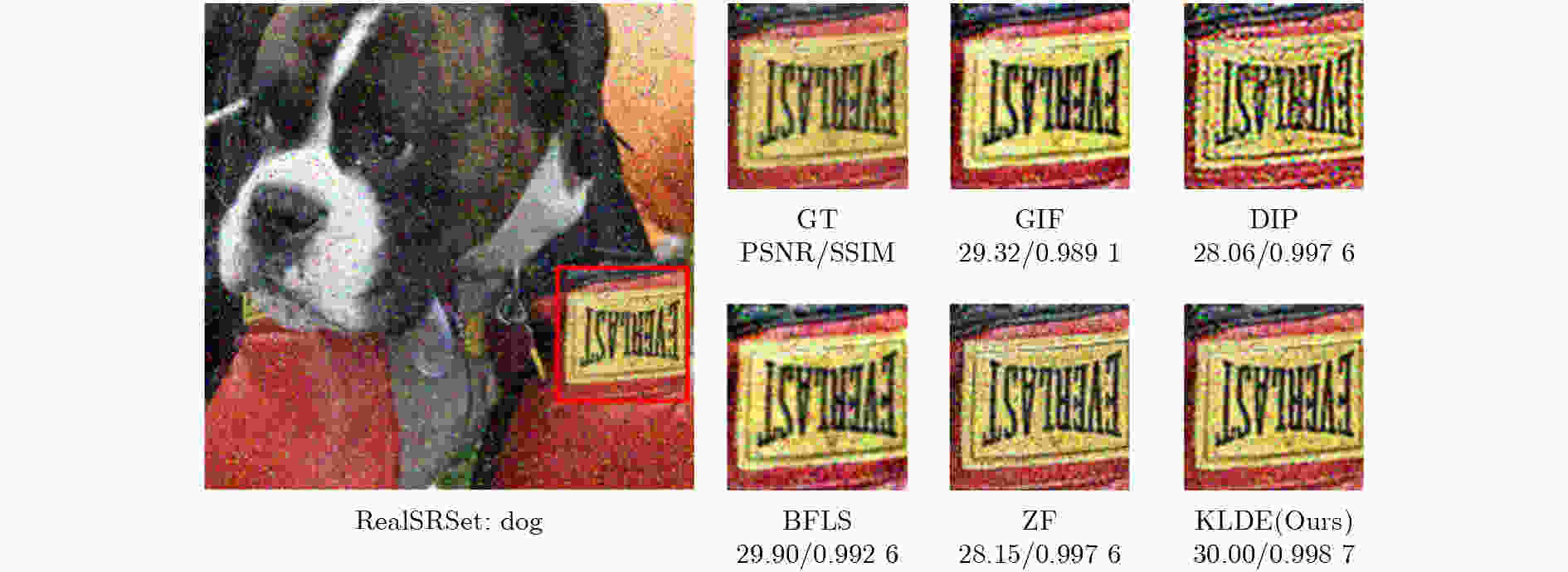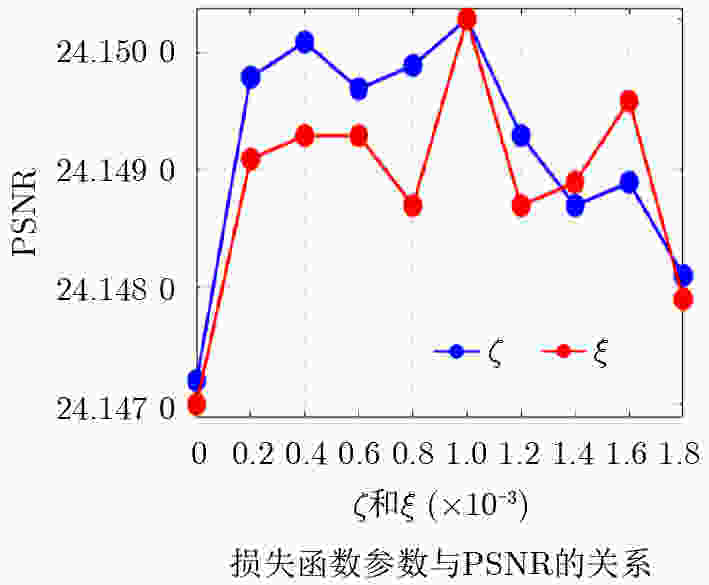Kepler’s Laws Inspired Single Image Detail Enhancement Algorithm
-
摘要: 近年来,基于残差学习的单幅图像细节增强算法备受关注,其通过更新残差层来拟合图像细节层,并与原图像线性叠加实现图像细节增强。然而,此更新过程使用的方法是贪心算法,极易使系统陷入局部最优解,进而限制了系统性能。鉴于此,受行星运动规律的启发,本研究将残差更新类比为行星空间位置的动态调整,借鉴开普勒定律,通过计算确定行星的全局最优位置,进而实现残差层的精准更新。具体而言,将输入图像分块,对每个原始图像块,将其候选图像块视为“行星”,最佳匹配块视为“恒星”。通过计算每个“行星”与原始图像块之间的差异、“行星”的速度和“恒星”的引力,更新“行星”和“恒星”的位置,直至“恒星”的位置达到收敛状态,确定全局最佳匹配块的位置。实验结果显示,本研究提出的算法在视觉效果及量化评估方面均优于当前方法。值得一提的是,在BSDS200数据集4倍增强因子的结果中,本研究提出的方法比当前流行方法QWLS的量化指标PSNR和SSIM分别高出1.51 dB和
0.0413 ,彰显了本研究算法的优越性。Abstract:Objective In recent years, single-image detail enhancement based on residual learning have attracted extensive attention. These algorithms update the residual layer by leveraging the similarity between the residual layer and the detail layer, and then linearly combine it with the original image to enhance image details. However, this update process is a greedy algorithm, which is prone to trapping the system in local optima, thereby limiting the overall performance. Inspired by Kepler’s laws, this study analogizes the residual update to the dynamic adjustment of planetary positions. By applying Kepler's laws and calculating the global optimal position of the planets, precise updates of the residual layer are achieved. Methods The input image is divided into multiple blocks. For each block, its candidate blocks are regarded as “lanets”, and the best matching block is treated as a “star”. The positions of the “planets” and the “star” are updated by calculating the differences between each “planet” and the original image block until the positions converge, thereby determining the location of the global optimal matching block. Results and Discussions In this study, 16 algorithms are tested on three datasets at two different magnification levels ( Table 1 ). The test results show that the proposed algorithm performs excellently in both PSNR and SSIM evaluations. During the detail enhancement process, compared with other algorithms, the proposed algorithm demonstrates stronger edge preservation capabilities (Fig.7 ). However, the algorithm proposed in this paper is not robust to noise (Fig.8 -Fig.10 ), and the performance of the detail-enhanced images continues to decline as the noise intensity increases (Fig.11 ). Both the initial gravitational constant and the gravitational attenuation rate constant show a fluctuating trend, that is, they first increase and then decrease (Fig.12 ). When the gradient loss and texture loss weights are set to 0.001, the KLDE system achieves the best performance (Fig.13 ).Conclusions This study proposes a single-image detail enhancement algorithm inspired by Keple’s laws. By analogizing the residual update process to the dynamic adjustment of planetary positions, the algorithm utilizes Kepler's laws to optimize the update of residual layers, alleviating the local optimum problem caused by greedy search and achieving more precise image detail enhancement. Experimental results show that this algorithm outperforms existing methods in both visual effects and quantitative metrics, and can achieve natural enhancement performance. However, it is worth noting that the algorithm has a relatively long running time, with the computational bottleneck being limited by the iterative update of candidate blocks and the calculation of parameters such as gravity. Future work will focus on optimizing the algorithm structure to reduce invalid searches and improve system operation efficiency. Additionally, this algorithm does not require training and has good performance, and it shows potential and promotion value in scenarios such as high-precision offline image enhancement. -
表 1 增强因子为2和4时在基准数据集下的指标对比
模型 增强因子 RealSRSet[33] BSDS200[34] T91[35] PSNR(dB) SSIM PSNR(dB) SSIM PSNR(dB) SSIM WLS(TOG 2008)[15] X2 20.16 0.8235 17.74 0.7439 18.63 0.7693 GIF(TPAMI 2012)[8] 24.45 0.8908 23.89 0.8344 23.82 0.8444 WGIF(TIP 2015)[9] 25.66 0.8867 27.91 0.8816 24.85 0.8517 GGIF(TIP 2015)[10] 27.35 0.9256 27.41 0.8865 26.95 0.8955 ZF(ICCV 2017)[31] 20.65 0.7731 22.56 0.7966 24.09 0.9237 BFLS(TCSVT 2018)[37] 22.51 0.8318 23.06 0.7965 21.63 0.7659 ILS(TOG 2020)[17] 26.16 0.8761 25.09 0.8313 23.48 0.8093 DIP(IJCV 2020)[39] 23.00 0.7970 23.75 0.7657 25.87 0.8232 IPRH(JEI 2020)[32] 26.30 0.9147 24.97 0.8629 28.48 0.9102 TH(TPAMI 2021)[38] 20.70 0.7872 21.32 0.7620 21.43 0.7616 DeepFSPIS(ACM MM 2022)[40] 26.13 0.8640 27.05 0.8640 25.67 0.8260 CSGIS(CGF 2022)[41] 24.50 0.8340 25.32 0.8355 25.18 0.8216 PTF(TOG 2023)[36] 18.43 0.7365 19.12 0.7116 18.76 0.6939 MGPNet(SPL 2024)[42] 20.56 0.6953 23.38 0.8430 21.18 0.7489 QWLS(IJCV 2024)[18] 24.54 0.8894 26.83 0.9099 27.50 0.9153 KLDE(本研究) 31.20 0.9718 28.59 0.9344 32.32 0.9626 WLS(TOG 2008)[15] X4 - - - - - - GIF(TPAMI 2012)[8] 19.53 0.7638 18.71 0.6637 18.73 0.6862 WGIF(TIP 2015)[9] 20.87 0.7781 22.54 0.7517 19.77 0.7081 GGIF(TIP 2015)[10] 22.09 0.8294 21.90 0.7517 21.53 0.7699 ZF(ICCV 2017)[31] 16.60 0.6038 18.07 0.6218 19.36 0.6081 BFLS(TCSVT 2018)[37] 18.70 0.6982 18.07 0.6174 16.95 0.5898 ILS(TOG 2020)[17] 21.10 0.7491 19.81 0.6636 18.49 0.6432 DIP(IJCV 2020)[39] 19.69 0.6988 21.16 0.6860 22.71 0.7285 IPRH(JEI 2020)[32] 21.47 0.8039 20.14 0.7105 23.30 0.7782 TH(TPAMI 2021)[38] 16.72 0.6354 16.77 0.5786 16.91 0.5822 DeepFSPIS(ACM MM 2022)[40] 20.88 0.7220 21.59 0.7030 20.47 0.6510 CSGIS(CGF 2022)[41] 19.16 0.6651 19.82 0.6523 19.77 0.6344 PTF(TOG 2023)[36] 15.09 0.5777 15.17 0.5244 14.89 0.5080 MGPNet(SPL 2024)[42] 16.86 0.5422 19.47 0.7070 18.02 0.6018 QWLS(IJCV 2024)[18] 20.27 0.7721 21.83 0.7906 22.88 0.7950 KLDE(本研究) 25.87 0.9181 23.34 0.8319 26.84 0.8921 注:黑色加粗字体为每列最优值,加下划线字体为每列次优值 表 2 MOS比较
表 3 数据集RealSRSet上增强因子为4时运行时间比较
模型 平均运行时间/s PSNR(dB) GIF(TPAMI 2012)[8] 0.04 19.53 WGIF(TIP 2015)[9] 0.08 20.87 GGIF(TIP 2015)[10] 0.08 22.09 ZF(ICCV 2017)[31] 0.04 16.60 BFLS(TCSVT 2018)[37] 0.52 18.70 ILS(TOG 2020)[17] 0.44 21.10 DIP(IJCV 2020)[39] 4.01 19.69 IPRH(JEI 2020)[32] 0.03 21.47 TH(TPAMI 2021)[38] 0.39 16.72 DeepFSPIS(ACM MM 2022)[40] 0.52 20.88 CSGIS(CGF 2022)[41] 0.16 19.16 PTF(TOG 2023)[36] 7.64 15.09 MGPNet(SPL 2024)[42] 0.21 16.86 QWLS(IJCV 2024)[18] 0.39 20.27 KLDE(本研究) 13.29 25.87 注:黑色加粗字体为本研究算法 -
[1] 徐少平, 熊明海, 周常飞. 利用近清图像空间搜索的深度图像先验降噪模型[J]. 电子与信息学报, 2024, 46(11): 4229–4235. doi: 10.11999/JEIT240114.XU Shaoping, XIONG Minghai, ZHOU Changfei. Deep Image Prior Denoising Model Using Relatively Clean Image Space Search[J]. Journal of Electronics & Information Technology, 2024, 46(11): 4229–4235. doi: 10.11999/JEIT240114. [2] 程德强, 袁航, 钱建生, 等. 基于深层特征差异性网络的图像超分辨率算法[J]. 电子与信息学报, 2024, 46(3): 1033–1042. doi: 10.11999/JEIT230197.CHENG Deqiang, YUAN Hang, QIAN Jiansheng, KOU Qiqi, JIANG He. Image Super-Resolution Algorithms Based on Deep Feature Differentiation Network[J]. Journal of Electronics & Information Technology, 2024, 46(3): 1033–1042. doi: 10.11999/ JEIT230179. doi: 10.11999/JEIT230197. [3] Li F, Bai H, Zhao Y. Detail-preserving image super-resolution via recursively dilated residual network[J]. Neurocomputing, 2019, 358: 285–293. doi: 10.1016/j.neucom.2019.05.042. [4] Zhao M, Cao G, Huang X, et al. Hybrid transformer-CNN for real image denoising[J]. IEEE Signal Processing Letters, 2022, 29: 1252–1256. doi: 10.1109/LSP.2022.3176486. [5] Cao G, Tian H, Yu L, et al. Acceleration of histogram‐based contrast enhancement via selective downsampling[J]. IET Image Processing, 2018, 12(3): 447–452. doi: 10.1049/iet-ipr.2017.0789. [6] Narendra P M. A separable median filter for image noise smoothing[J]. IEEE Transactions on Pattern Analysis and Machine Intelligence, 1981(1): 20–29. doi: 10.1109/tpami.1981.4767047. [7] Tomasi C, Manduchi R. Bilateral filtering for gray and color images[C]//International Conference on Computer Vision, IEEE, 1998: 839-846. doi: 10.1109/iccv.1998.710815. [8] He K, Sun J, Tang X. Guided image filtering[J]. Transactions on Pattern Analysis and Machine Intelligence, IEEE, 2012, 35(6): 1397–1409. doi: 10.1109/TPAMI.2012.213. [9] Li Z, Zheng J, Zhu Z, et al. Weighted guided image filtering[J]. IEEE Transactions on Image processing, 2014, 24(1): 120–129. doi: 10.1109/TIP.2014.2371234. [10] Kou F, Chen W, Wen C, et al. Gradient domain guided image filtering[J]. IEEE Transactions on Image Processing, 2015, 24(11): 4528–4539. doi: 10.1109/TIP.2015.2468183. [11] Cheng J, Li Z, Gu Z, et al. Structure-preserving guided retinal image filtering and its application for optic disk analysis[J]. IEEE Transactions on Medical Imaging, 2018, 37(11): 2536–2546. doi: 10.1109/TMI.2018.2838550. [12] Sun Z, Han B, Li J, et al. Weighted guided image filtering with steering kernel[J]. IEEE Transactions on Image Processing, 2019, 29: 500–508. [13] Tan A, Liao H, Zhang B, et al. Infrared Image Enhancement Algorithm Based on Detail Enhancement Guided Image Filtering[J]. The Visual Computer, 2023, 39: 6491–6502. doi: 10.1007/s00371-022-02741-6. [14] Li J, Han Y, Gao Y, et al. An enhance relative total variation with BF model for edge-preserving image smoothing[J]. IEEE Transactions on Circuits and Systems for Video Technology, 2023, 33(10): 5420–5432. doi: 10.1109/TCSVT.2023.3255208. [15] Rudin L I, Osher S, Fatemi E. Nonlinear total variation based noise removal algorithms[J]. Physica D: nonlinear phenomena, 1992, 60(1-4): 259–268. doi: 10.1016/0167-2789(92)90242-F. [16] Xu L, Yan Q, Xia Y, et al. Structure extraction from texture via relative total variation[J]. ACM Transactions on Graphics (TOG), 2012, 31(6): 1–10. doi: 10.1145/2366145.2366158. [17] Liu W, Zhang P, Huang X, et al. Real-time image smoothing via iterative least squares[J]. ACM Transactions on Graphics (TOG), 2020, 39(3): 1–24. doi: 10.1145/3388887. [18] Liu W, Zhang P, Qin H, et al. Fast Global Image Smoothing via Quasi Weighted Least Squares[J]. International Journal of Computer Vision, 2024: 1-30. doi: 10.1007/s11263-024-02105-8. [19] He L, Xie Y, Xie S, et al. Iterative self-guided image filtering[J]. IEEE Transactions on Circuits and Systems for Video Technology, 2024, 34(8): 7537–7549. doi: 10.1109/TCSVT.2024.3374758. [20] Li S, Liu Y, Zeng J, et al. Image smoothing method based on global gradient sparsity and local relative gradient constraint optimization[J]. Scientific Reports, 2024, 14(1): 15152. doi: 10.1038/s41598-024-65886-5. [21] Sasaki T, Bandoh Y, Kitahara M. Sparse Regularization Based on Reverse Ordered Weighted L 1-Norm and Its Application to Edge-Preserving Smoothing[C]// International Conference on Acoustics, Speech and Signal Processing (ICASSP). IEEE, 2024: 9531-9535. doi: 10.1109/ICASSP48485.2024.10448119. [22] Li J, Han Y, Gao Y, et al. An enhance relative total variation with BF model for edge-preserving image smoothing[J]. IEEE Transactions on Circuits and Systems for Video Technology, 2023, 33(10): 5420–5432. doi: 10.1109/TCSVT.2023.3255208. [23] Qi H, Li F, Chen P, et al. Edge-preserving image restoration based on a weighted anisotropic diffusion model[J]. Pattern Recognition Letters, 2024, 184: 80–88. doi: 10.1016/j.patrec.2024.06.007. [24] Xu L, Ren J, Yan Q, et al. Deep edge-aware filters[C]//International Conference on Machine Learning. , 2015: 1669-1678. [25] Liu S, Pan J, Yang M H. Learning recursive filters for low-level vision via a hybrid neural network[C]// European Conference on Computer Vision, 2016: 560-576. doi: 10.1007/978-3-319-46493-0_34. [26] Fan Q, Yang J, Hua G, et al. A generic deep architecture for single image reflection removal and image smoothing[C]//International Conference on Computer Vision, IEEE, 2017: 3238-3247. doi: 10.1109/iccv.2017.351. [27] Yang Y, Tang L, Yan T, et al. Parameterized L0 Image Smoothing With Unsupervised Learning[J]. IEEE Transactions on Emerging Topics in Computational Intelligence, 2024, 8(2): 1938–1951. doi: 10.1109/TETCI.2024.3359060. [28] Zhang F, Tian M, Li Z, et al. Lookup table meets local laplacian filter: pyramid reconstruction network for tone mapping[J]. Advances in Neural Information Processing Systems, 2023, 36: 57558–57569. doi: 10.48550/arXiv.2310.17190. [29] Qi H, Tan S, Luo X. Self-supervised dual generative networks for edge-preserving image smoothing [C]//IEEE International Conference on Acoustics, Speech and Signal Processing (ICASSP), 2024: 7215-7219. doi : 10.1109/ICASSP48485.2024.10448288. [30] Kim D, Park J, Jung J, et al. Lens distortion correction and enhancement based on local self-similarity for high-quality consumer imaging systems[J]. IEEE Transactions on Consumer Electronics, 2014, 60(1): 18–22. doi: 10.1109/tce.2014.6780920. [31] Tao X, Zhou C, Shen X, et al. Zero-order reverse filtering[C]//International Conference on Computer Vision, IEEE, 2017: 222-230. doi: 10.1109/ iccv.2017.33. [32] Jiang H, Asad M, Huang X, et al. Learning in-place residual homogeneity for single image detail enhancement[J]. Journal of Electronic Imaging, 2020, 29(4): 043016–043016. doi: 10.1117/1.jei.29.4.043016. [33] Zhang K, Liang J, Van Gool L, et al. Designing a practical degradation model for deep blind image super-resolution[C]//International Conference on Computer Vision, IEEE, 2021: 4791-4800. doi: 10.1109/iccv48922.2021.00475. [34] Arbelaez P, Maire M, Fowlkes C, et al. Contour detection and hierarchical image segmentation[J]. IEEE transactions on pattern analysis and machine intelligence, 2010, 33(5): 898–916. doi: 10.1109/ TPAMI.2010.161. doi: 10.1109/TPAMI.2010.161. [35] Dong C, Loy C C, He K, et al. Learning a deep convolutional network for image super-resolution[C]//European Conference on Computer Vision, 2014: 184-199. doi: 10.1007/978-3-319-10593-2_13. [36] Zhang Q, Jiang H, Nie Y, et al. Pyramid Texture Filtering[J]. ACM Transactions on Graphics (TOG), 2023, 42(4): 1–11. doi: 10.1145/3592120. [37] Liu W, Zhang P, Chen X, et al. Embedding bilateral filter in least squares for efficient edge-preserving image smoothing[J]. IEEE Transactions on Circuits and Systems for Video Technology, 2018, 30(1): 23–35. doi: 10.1109/TCSVT.2018.2890202. [38] Liu W, Zhang P, Lei Y, et al. A generalized framework for edge-preserving and structure-preserving image smoothing[J]. IEEE Transactions on Pattern Analysis and Machine Intelligence, 2021, 44(10): 6631–6648. doi: 10.1109/TPAMI.2021.3097891. [39] Dmitry U, Vedaldi A, Victor L. Deep image prior[J]. International Journal of Computer Vision, 2020, 128(7): 1867-1888. [37] doi: 10.1007/s11263-020-01303-4. [40] Li M, Fu Y, Li X, et al. Deep flexible structure preserving image smoothing[C]//ACM International Conference on Multimedia, 2022: 1875-1883. doi: 10.1145/3503161.3547857. [41] Wang J, Wang Y, Feng Y, et al. Contrastive Semantic‐Guided Image Smoothing Network [C]//Computer Graphics Forum. 2022, 41(7): 335–346. doi: 10.1111/ cgf.14681. [42] He X, Quan Y, Xu Y, et al. Image Smoothing via Multiscale Global Perception[J]. IEEE Signal Processing Letters, 2024, 31: 411–415. doi: 10.1109/ LSP.2024.3354549. doi: 10.1109/LSP.2024.3354549. -






 下载:
下载:














 下载:
下载:
